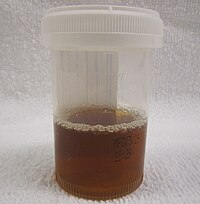
Photo from wikipedia
Rhabdomyolysis is a relatively rare condition, but its clinical consequences are frequently dramatic in terms of both morbidity and mortality. Although no consensus has been reached so far about the… Click to show full abstract
Rhabdomyolysis is a relatively rare condition, but its clinical consequences are frequently dramatic in terms of both morbidity and mortality. Although no consensus has been reached so far about the precise definition of this condition, the term rhabdomyolysis describes a rapid breakdown of striated, or skeletal, muscle. It is hence characterized by the rupture and necrosis of muscle fibers, resulting in release of cell degradation products and intracellular elements within the bloodstream and extracellular space. Notably, the percentage of patients with rhabdomyolysis who develop acute kidney injury, the most dramatic consequence, varies from 13% to over 50% according to both the cause and the clinical and organizational setting where they are diagnosed. Despite direct muscle injury (i.e., traumatic rhabdomyolysis) remains the most common cause, additional causes, frequently overlapping, include hypoxic, physical, chemical or biological factors. The conventional triad of symptoms includes muscle pain, weakness and dark urine. The laboratory diagnosis is essentially based on the measurement of biomarkers of muscle injury, being creatine kinase (CK) the biochemical "gold standard" for diagnosis, and myoglobin the "gold standard" for prognostication, especially in patients with non-traumatic rhabdomyolysis. The essential clinical management in the emergency department is based on a targeted intervention to manage the underlying cause, combined with infusion of fluids and eventually sodium bicarbonate. We will present and discuss in this article the pathophysiological and clinical features of non-traumatic rhabdomyolysis, focusing specifically on Emergency Department (ED) management.
Journal Title: Clinical biochemistry
Year Published: 2017
Link to full text (if available)
Share on Social Media: Sign Up to like & get
recommendations!